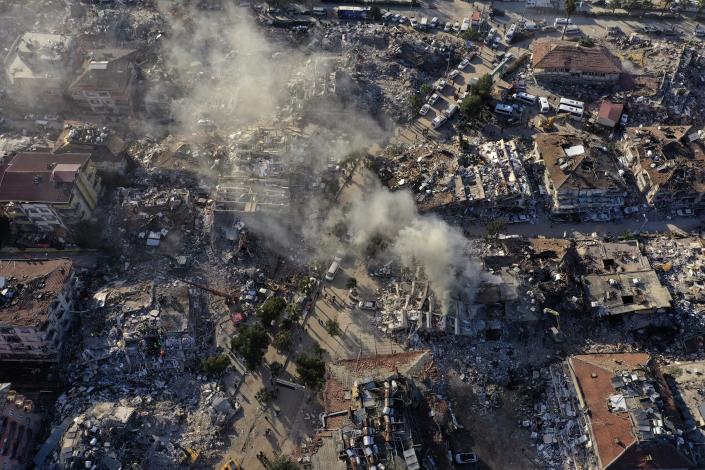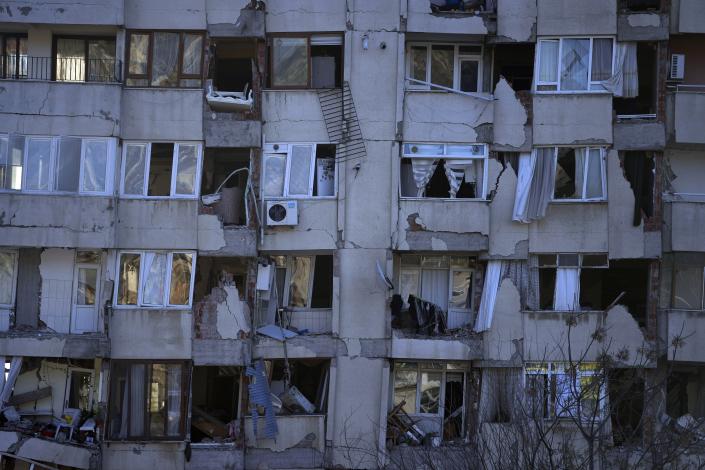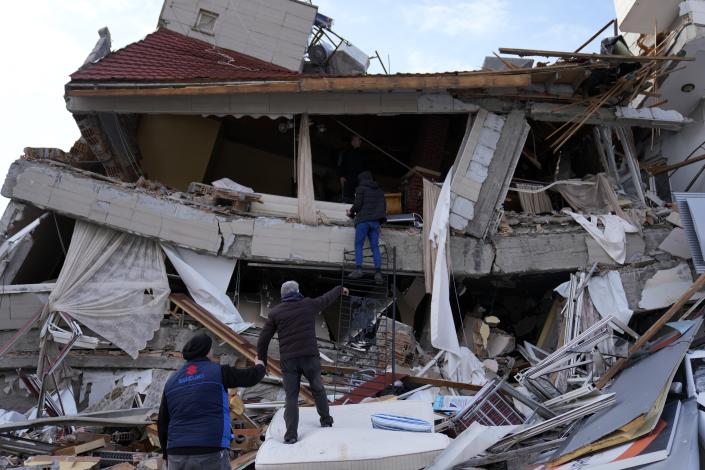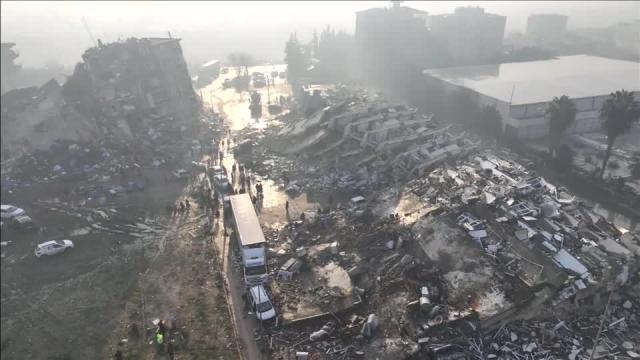

1 / 18
Destroyed buildings are seen from above in Antakya, southeastern Turkey, Thursday, Feb. 9, 2023. The Turkish government has for years tempted fate by not enforcing modern construction codes at the same time it was allowing — and in some cases, encouraging — a real estate boom in earthquake-prone areas, according to experts in geology and engineering who repeatedly issued warnings.
(AP Photo/Hussein Malla)
ZEYNEP BILGINSOY and SUZAN FRASER
Fri, February 10, 2023
ISTANBUL (AP) — Turkey has for years tempted fate by not enforcing modern construction codes while allowing — and in some cases, encouraging — a real estate boom in earthquake-prone areas, experts say.
The lax enforcement, which experts in geology and engineering have long warned about, is gaining renewed scrutiny in the aftermath of this week's devastating earthquakes, which flattened thousands of buildings and killed more than 22,700 people across Turkey and Syria.
“This is a disaster caused by shoddy construction, not by an earthquake,” said David Alexander, a professor of emergency planning at University College London.
It is common knowledge that many buildings in the areas pummeled by this week’s two massive earthquakes were built with inferior materials and methods, and often did not comply with government standards, said Eyup Muhcu, president of the Chamber of Architects of Turkey.
He said that includes many old buildings, but also apartments erected in recent years — nearly two decades after the country brought its building codes up to modern standards. “The building stock in the area was weak and not sturdy, despite the reality of earthquakes,” Muhcu said.
The problem was largely ignored, experts said, because addressing it would be expensive, unpopular and restrain a key engine of the country's economic growth.
To be sure, the back-to-back earthquakes that demolished or damaged at least 12,000 buildings were extremely powerful — their force magnified by the fact that they occurred at shallow depths. The first 7.8 magnitude quake occurred at 4:17 a.m., making it even more difficult for people to escape their buildings as the earth shook violently. And President Recep Tayyip Erdogan has acknowledged “shortcomings” in the country's response.
But experts said there is a mountain of evidence — and rubble — pointing to a harsh reality about what made the quakes so deadly: Even though Turkey has, on paper, construction codes that meet current earthquake-engineering standards, they are too rarely enforced, explaining why thousands of buildings crumbled.
In a country crisscrossed by geological fault lines, people are on edge about when and where the next earthquake might hit — particularly in Istanbul, a city of more than 15 million that is vulnerable to quakes.
Since the disaster, Erdogan's minister of justice said it will investigate the destroyed buildings. “Those who have been negligent, at fault and responsible for the destruction following the earthquake will answer to justice,” Bekir Bozdag said Thursday.
But several experts said any serious investigation into the root of weak enforcement of building codes must include a hard look at the policies of Erdogan, as well as regional and local officials, who oversaw — and promoted — a construction boom that helped drive economic growth.
Shortly before Turkey's last presidential and parliamentary election in 2018, the government unveiled a sweeping program to grant amnesty to companies and individuals responsible for certain violations of the country's building codes. By paying a fine, violators could avoid having to bring their buildings up to code. Such amnesties have been used by previous governments ahead of elections as well.
As part of that amnesty program, the government agency responsible for enforcing building codes acknowledged that more than half of all buildings in Turkey — accounting for some 13 million apartments— were not in compliance with current standards.
The types of violations cited in that report by the Ministry of Environment and Urbanization were wide-ranging, including homes built without permits, buildings that added extra floors or expanded balconies without authorization, and the existence of so-called squatter homes inhabited by low-income families.
The report did not specify how many buildings were in violation of codes related to earthquake-proofing or basic structural integrity, but the reality was clear.
“Construction amnesty doesn’t mean the building is sturdy,” the current head of the Ministry of Environment and Urbanization, Murat Kurum, said in 2019.
In 2021, the Chamber of Geological Engineers of Turkey published a series of reports raising red flags about existing buildings and new construction taking place in areas leveled by this week's quakes, including Kahramanmaras, Hatay and Osmaniye. The Chamber urged the government to conduct studies to ensure that buildings were up to code and built on safe locations.
A year earlier, the Chamber issued a report that directly called out policies of “slum amnesty, construction amnesty” as dangerous and warned that “indifference to disaster safety culture" would lead to preventable deaths.
Since 1999, when two powerful earthquakes hit northwest Turkey, near Istanbul — the stronger one killing some 18,000 people — building codes have been tightened and a process of urban renewal has been underway.
But the upgrades aren't happening fast enough, especially in poorer cities.
Builders commonly use lower quality materials, hire fewer professionals to oversee projects and don't adhere to various regulations as a way of keeping costs down, according to Muhcu, president of the country's Chamber of Architects.
He said the Turkish government’s so-called “construction peace” introduced before the 2018 general elections as a way to secure votes has, in effect, legalized unsafe buildings.
“We are paying for it with thousands of deaths, the destruction of thousands of buildings, economic losses,” Muhcu said.
Even new apartment buildings advertised as safe were ravaged by the quake.
In Hatay province, where casualties were highest and an airport runway and two public hospitals were destroyed, survivor Bestami Coskuner said he saw many new buildings, even “flashy” new ones had collapsed.
In Antakya, a historic city in Hatay, a 12-story building with 250 units that was completed in 2012 or 2013 collapsed, leaving an untold number dead, or still trapped alive. The Ronesans Rezidans was considered one of the “luxury” buildings in the area and was advertised as “a life project that is high quality” on Facebook with a pool, gym, beauty center and security.
On Friday, a contractor who oversaw the construction of that building was detained at Istanbul Airport before boarding a flight out of the country, Turkey’s official Anadolu news agency reported.
Another destroyed building in Antakya is the Guclu Bahce, which began construction in 2017 and opened with much fanfare in 2019 in a ceremony attended by Hatay’s mayor and other local officials, according to fact-checking website Dogrulukpayi.
In Malatya, the brand-new Asur apartments — billed as earthquake-proof in advertisements — sustained damage in the first quake, but residents escaped unharmed. Some residents who returned to the building to collect belongings managed a second lucky escape when the second strong temblor hit, causing the building to slide toward one side, according to video shown on TikTok and verified by fact-checking website Teyit.
The devastation across Turkey comes at a sensitive time for President Erdogan, who faces tough parliamentary and presidential elections in May amid an economic downturn and high inflation.
Erdogan regularly touts the country's construction boom over the past two decades, including new airports, roads, bridges and hospitals, as proof of his success during more than two decades in power.
On his tour of the devastation Wednesday and Thursday, Erdogan pledged to rebuild destroyed homes within the year.
“We know how to do this business," he said. “We are a government that has proved itself on these issues. We will.”
___
Fraser reported from Ankara, Turkey. Robert Badendieck in Istanbul and Danica Kirka in London contributed.
As part of that amnesty program, the government agency responsible for enforcing building codes acknowledged that more than half of all buildings in Turkey — accounting for some 13 million apartments— were not in compliance with current standards.
The types of violations cited in that report by the Ministry of Environment and Urbanization were wide-ranging, including homes built without permits, buildings that added extra floors or expanded balconies without authorization, and the existence of so-called squatter homes inhabited by low-income families.
The report did not specify how many buildings were in violation of codes related to earthquake-proofing or basic structural integrity, but the reality was clear.
“Construction amnesty doesn’t mean the building is sturdy,” the current head of the Ministry of Environment and Urbanization, Murat Kurum, said in 2019.
In 2021, the Chamber of Geological Engineers of Turkey published a series of reports raising red flags about existing buildings and new construction taking place in areas leveled by this week's quakes, including Kahramanmaras, Hatay and Osmaniye. The Chamber urged the government to conduct studies to ensure that buildings were up to code and built on safe locations.
A year earlier, the Chamber issued a report that directly called out policies of “slum amnesty, construction amnesty” as dangerous and warned that “indifference to disaster safety culture" would lead to preventable deaths.
Since 1999, when two powerful earthquakes hit northwest Turkey, near Istanbul — the stronger one killing some 18,000 people — building codes have been tightened and a process of urban renewal has been underway.
But the upgrades aren't happening fast enough, especially in poorer cities.
Builders commonly use lower quality materials, hire fewer professionals to oversee projects and don't adhere to various regulations as a way of keeping costs down, according to Muhcu, president of the country's Chamber of Architects.
He said the Turkish government’s so-called “construction peace” introduced before the 2018 general elections as a way to secure votes has, in effect, legalized unsafe buildings.
“We are paying for it with thousands of deaths, the destruction of thousands of buildings, economic losses,” Muhcu said.
Even new apartment buildings advertised as safe were ravaged by the quake.
In Hatay province, where casualties were highest and an airport runway and two public hospitals were destroyed, survivor Bestami Coskuner said he saw many new buildings, even “flashy” new ones had collapsed.
In Antakya, a historic city in Hatay, a 12-story building with 250 units that was completed in 2012 or 2013 collapsed, leaving an untold number dead, or still trapped alive. The Ronesans Rezidans was considered one of the “luxury” buildings in the area and was advertised as “a life project that is high quality” on Facebook with a pool, gym, beauty center and security.
On Friday, a contractor who oversaw the construction of that building was detained at Istanbul Airport before boarding a flight out of the country, Turkey’s official Anadolu news agency reported.
Another destroyed building in Antakya is the Guclu Bahce, which began construction in 2017 and opened with much fanfare in 2019 in a ceremony attended by Hatay’s mayor and other local officials, according to fact-checking website Dogrulukpayi.
In Malatya, the brand-new Asur apartments — billed as earthquake-proof in advertisements — sustained damage in the first quake, but residents escaped unharmed. Some residents who returned to the building to collect belongings managed a second lucky escape when the second strong temblor hit, causing the building to slide toward one side, according to video shown on TikTok and verified by fact-checking website Teyit.
The devastation across Turkey comes at a sensitive time for President Erdogan, who faces tough parliamentary and presidential elections in May amid an economic downturn and high inflation.
Erdogan regularly touts the country's construction boom over the past two decades, including new airports, roads, bridges and hospitals, as proof of his success during more than two decades in power.
On his tour of the devastation Wednesday and Thursday, Erdogan pledged to rebuild destroyed homes within the year.
“We know how to do this business," he said. “We are a government that has proved itself on these issues. We will.”
___
Fraser reported from Ankara, Turkey. Robert Badendieck in Istanbul and Danica Kirka in London contributed.
‘Why did we give all these warnings?’: Turkey earthquake region was flagged as danger zone at least 24 years ago
24 years after the deadly Izmit earthquake, Turkey sees 6,000 buildings collapse, thousands dead -- and no accountability in sight
Tuvana Sahinturk
Wed, February 8, 2023
On Monday morning, Turkey woke up to a disastrous tragedy. At 4:17 a.m. local time, a 7.8-magnitude earthquake hit near Gaziantep, a city in Southern Turkey, with 120 recorded aftershocks following in the next 12 hours. The earthquake was named the deadliest in a decade, with casualties in Turkey and Syria surpassing the 10,000 mark.
This is not the first big earthquake Turkey has faced, yet it is one of the deadliest. Growing up in Turkey, I was always warned and taught about how dangerous earthquakes can be. From classes to television, there was always a voice telling us how to place our furniture, prepare earthquake emergency kits, and countless drills in case tragedy ever struck.

A man stands inside a destroyed building as others react, in Iskenderun town, southern Turkey, Tuesday, Feb. 7, 2023. A powerful earthquake hit southeast Turkey and Syria early Monday, toppling hundreds of buildings and killing and injuring thousands of people. (AP Photo/Hussein Malla)
The 1999 Izmit earthquake, still deeply mourned, was the biggest earthquake in Turkey I knew about growing up, causing almost 20,000 deaths, and collapsing over 100,000 buildings. My mother was pregnant with me at the time, and she was still so terrified when I became old enough to understand what an earthquake is. The danger and horror of earthquakes are deeply understood by the Turkish people, there has been more than enough suffering to take earthquake preparation seriously. So how did over 6,000 buildings collapse once again, more than 20 years later?
The morning of the earthquake, geoscientist, Naci Görür, went on live television, unable to hide his despair.
“I was woken up at 4 a.m. in the morning, I cried for an hour, and I am still crying. It’s the place we have been warning about for years. Not a single local authority called to ask what they can do. Why did we give all these warnings?” he said.
Görür’s perspective is one that suggests that the right preparation and inspection could have at least decreased the scope of the disaster that struck the morning of Feb. 6th.
In an interview with The Guardian, Dr. Henry Bang, a geologist and disaster management expert explained what could have caused so many buildings to collapse in different ways.
RELATED: How you can help Turkey, Syria victims
“Those whose walls have crumbled to the ground are probably very old buildings that were built with relatively weaker building materials. The [multi] story buildings that have collapsed like a pack of cards were probably not built with earthquake-resistant design features,” said Bang.
After the 1999 earthquake, many pointed their fingers at the outdated building codes that were still in place. So, Turkey introduced modern building codes hoping to be better prepared next time.
The problem is there are many ways to cheat, like replacing reinforcing rods with styrofoam or using outdated procedures. Whether the inspections that are supposed to take place inside these buildings were conducted regularly still remains a question, and one thing stands true: the contractors that chose to cheat the system for extra cash now carry the responsibility for the thousands of lives that were lost in the earthquake.

Drone footage shows devastation from Turkey quake
STORY: Drone footage captured by Reuters gave a bird's-eye view of Hatay's landscape littered with mounds of rubble from collapsed buildings, while others stood precariously on an angle with long cracks and fissures slashing across their facades.Rescue teams worked early on Tuesday to reach people trapped in the rubble of buildings in southern Turkey as the death toll in the country from Monday's (February 6) earthquake continued to rise. The magnitude 7.8 quake hit Turkey and northwest Syria, toppling entire apartment blocks, wrecking hospitals, and leaving thousands more people injured or homeless.Nearly 8,000 people have been rescued from 4,758 buildings destroyed in the tremors a day earlier, Turkey's Disaster and Emergency Management Authority (AFAD) said in its latest statement.
While measurements and preparation play a big part in earthquake management, Turkey still sits in a highly seismically active area, making the natural disaster almost non-avoidable. In an interview with Scientific American, Ross Stein, CEO of the catastrophe modelling company Temblor, explains that Turkey is squeezed by a giant tectonic vise, meaning that the country is being forced outward to the west, spilling into the Mediterranean and ultimately being pushed beneath Crete in a subduction zone similar to the one seen off of Japan.
In earthquake-affected cities, search and rescue efforts are still ongoing. Donating and spreading secure assembly locations and helpful information can go a long way toward helping the survivors.
24 years after the deadly Izmit earthquake, Turkey sees 6,000 buildings collapse, thousands dead -- and no accountability in sight
Tuvana Sahinturk
Wed, February 8, 2023
On Monday morning, Turkey woke up to a disastrous tragedy. At 4:17 a.m. local time, a 7.8-magnitude earthquake hit near Gaziantep, a city in Southern Turkey, with 120 recorded aftershocks following in the next 12 hours. The earthquake was named the deadliest in a decade, with casualties in Turkey and Syria surpassing the 10,000 mark.
This is not the first big earthquake Turkey has faced, yet it is one of the deadliest. Growing up in Turkey, I was always warned and taught about how dangerous earthquakes can be. From classes to television, there was always a voice telling us how to place our furniture, prepare earthquake emergency kits, and countless drills in case tragedy ever struck.
A man stands inside a destroyed building as others react, in Iskenderun town, southern Turkey, Tuesday, Feb. 7, 2023. A powerful earthquake hit southeast Turkey and Syria early Monday, toppling hundreds of buildings and killing and injuring thousands of people. (AP Photo/Hussein Malla)
The 1999 Izmit earthquake, still deeply mourned, was the biggest earthquake in Turkey I knew about growing up, causing almost 20,000 deaths, and collapsing over 100,000 buildings. My mother was pregnant with me at the time, and she was still so terrified when I became old enough to understand what an earthquake is. The danger and horror of earthquakes are deeply understood by the Turkish people, there has been more than enough suffering to take earthquake preparation seriously. So how did over 6,000 buildings collapse once again, more than 20 years later?
The morning of the earthquake, geoscientist, Naci Görür, went on live television, unable to hide his despair.
“I was woken up at 4 a.m. in the morning, I cried for an hour, and I am still crying. It’s the place we have been warning about for years. Not a single local authority called to ask what they can do. Why did we give all these warnings?” he said.
Görür’s perspective is one that suggests that the right preparation and inspection could have at least decreased the scope of the disaster that struck the morning of Feb. 6th.
In an interview with The Guardian, Dr. Henry Bang, a geologist and disaster management expert explained what could have caused so many buildings to collapse in different ways.
RELATED: How you can help Turkey, Syria victims
“Those whose walls have crumbled to the ground are probably very old buildings that were built with relatively weaker building materials. The [multi] story buildings that have collapsed like a pack of cards were probably not built with earthquake-resistant design features,” said Bang.
After the 1999 earthquake, many pointed their fingers at the outdated building codes that were still in place. So, Turkey introduced modern building codes hoping to be better prepared next time.
The problem is there are many ways to cheat, like replacing reinforcing rods with styrofoam or using outdated procedures. Whether the inspections that are supposed to take place inside these buildings were conducted regularly still remains a question, and one thing stands true: the contractors that chose to cheat the system for extra cash now carry the responsibility for the thousands of lives that were lost in the earthquake.

Drone footage shows devastation from Turkey quake
STORY: Drone footage captured by Reuters gave a bird's-eye view of Hatay's landscape littered with mounds of rubble from collapsed buildings, while others stood precariously on an angle with long cracks and fissures slashing across their facades.Rescue teams worked early on Tuesday to reach people trapped in the rubble of buildings in southern Turkey as the death toll in the country from Monday's (February 6) earthquake continued to rise. The magnitude 7.8 quake hit Turkey and northwest Syria, toppling entire apartment blocks, wrecking hospitals, and leaving thousands more people injured or homeless.Nearly 8,000 people have been rescued from 4,758 buildings destroyed in the tremors a day earlier, Turkey's Disaster and Emergency Management Authority (AFAD) said in its latest statement.
While measurements and preparation play a big part in earthquake management, Turkey still sits in a highly seismically active area, making the natural disaster almost non-avoidable. In an interview with Scientific American, Ross Stein, CEO of the catastrophe modelling company Temblor, explains that Turkey is squeezed by a giant tectonic vise, meaning that the country is being forced outward to the west, spilling into the Mediterranean and ultimately being pushed beneath Crete in a subduction zone similar to the one seen off of Japan.
In earthquake-affected cities, search and rescue efforts are still ongoing. Donating and spreading secure assembly locations and helpful information can go a long way toward helping the survivors.
Abhya Adlakha
·Editor, Yahoo News Canada
Mon, February 6, 2023
Earthquakes jolt Turkiye's provinces
People and emergency teams search for people in a destroyed building in Adana, Turkey, Monday, Feb. 6, 2023. A powerful quake has knocked down multiple buildings in southeast Turkey and Syria and many casualties are feared. (AP Photo/Khalil Hamra)
More than 2,300 people have died after a devastating, historic 7.8 magnitude earthquake ripped through Turkey and Syria, leaving destruction and debris and trapping hundreds of residents under rubble.
The quake, one of the strongest to hit the region in more than a 100 years, struck 23 km east of Nurdagi, in Turkey's Gaziantep province, the US Geological Survey said.
Authorities feared the death toll would rise further as rescuers searched through tangles of metal and concrete for survivors in a region beset by more than a decade of Syria’s civil war and a refugee crisis.
Warning: Images in this gallery are disturbing and depict death and destruction



No comments:
Post a Comment